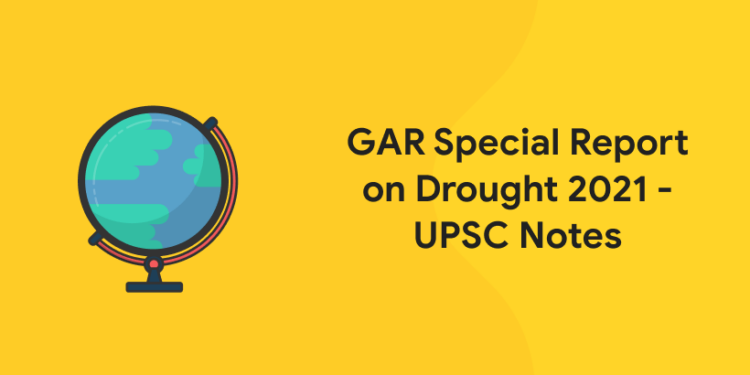Table of Contents
Drought creates considerably greater and more significant dangers to communities, ecosystems, and economy than can be evaluated. The most defenseless individuals bear the effects disproportionately. The necessary modifications to lower risk and enhance the experience of drought, however, become attainable as our understanding of the globally networked features of drought and other complex threats advances. In order to advance such understanding, this Global Assessment Report on Disaster Risk Reduction (GAR) Special Report on Drought 2021 seeks to make significant strides.
Future sustainable development is supported by societies, economics, and the environment, all of which are subject to complicated drought risk and its wide-ranging systemic effects. There is a need for new strategies to combat drought based on a systems and learning approach because traditional and existing approaches are continually overwhelmed by the systemic nature of drought risk, as stated in the 2019 GAR. Drought has always been a problem, but according to climate change predictions, it will become more common and more severe in many locations. This increases the urgency of important concerns including how effectively society is coping with drought and the availability of governance, resources, and strategies to lessen the cost of drought.
The objective of this report’s structure is to raise general understanding of drought’s characteristics and people’s experiences with it around the globe. It also strengthens the case for a novel method of managing the danger of a drought. The new strategy is built on successful governance models in which communities actively learn and adjust while attempting to prevent and lessen the risk of drought as well as adapt and respond to it. Through these procedures, the social, financial, institutional, and scientific communities are better equipped to understand the complexity of drought risk, develop strategies for reducing it, and become more adaptable as drought risk evolves. This paper also outlines enabling factors that, when present, can revolutionize local, national, and international drought management.
The GAR Special Report on Drought in 2021’s Major Findings
On June 17, 2021, the GAR Special Report on Drought was published. Additionally, this day is recognized as the International Day Against Desertification and Drought. The important conclusions from the UNDRR report are listed below:
- According to the Report, a clear definition of a drought is difficult to come by. Drought is a threat when there is unusually dry weather or a severe lack of water compared to normal circumstances.
- As the world gets closer to being 2°C warmer, the effects of drought are becoming more severe. Drought is one of the main causes of desertification and land degradation when it is not properly managed, which makes ecosystems more vulnerable and increases social unrest, especially in rural areas.
- For the residential water supply and irrigation of agricultural land, groundwater is a significant source of freshwater. One third to one half of the world’s population’s household needs are partially met by groundwater, which supplies between 38 and 50 percent of the world’s need for irrigation water. The security of water and food is seriously threatened by the depletion of groundwater resources and moderate to severe droughts.
- Changes in persistent atmospheric circulation patterns, typically linked to slowly altering atmospheric boundary conditions, are the main causes of drought.
- In the wake of medium- to large-scale disasters, 78 post-disaster needs evaluations were examined by the Food and Agriculture Organization (FAO). It discovered that 84 percent of the economic losses brought on by climate-related calamities were absorbed by agriculture. 36 percent of which was livestock output, and 42 percent of which had an impact on crop production. Drought occurrences were responsible for over 86 percent of all recorded loss and damage.
- Droughts harmed an estimated 2.7 billion people globally between 1900 and 2019, killing an estimated 11.7 million people.
- In particular, SDG1 (no poverty), SDG2 (zero hunger), SDG3 (excellent health and well-being), and SDG15 are being hampered by droughts and their negative effects, which put livelihoods at danger (life on land)
- What exactly are systemic risks? Systemic risks are characterized as interrelated failures in various system components that have the potential to trigger other events or perhaps the complete collapse of the system. In order to properly analyze and manage drought risk, it is necessary to take into account a variety of systemic risk characteristics.
- In the face of escalating aridity and desertification, the United Nations Convention to Combat Desertification (UNCCD) has established major goals and policy combinations for focusing money and coordinating economic incentives for drought risk reduction. These consist of:
- encouraging behavioral changes in people, businesses, the government, or society by offering financial incentives to grow crops that can withstand drought, for example
- compensating affected populations’ losses in order to prevent a spiraling poverty trap
- Sustaining a flow of financial capital that can, in economies where financial and credit markets are already constricted without the added stress of droughts, either permit the making of profitable investments or encourage the efficient operation of commodity markets
- According to the paper, frequency, severity, duration, cessation, affected area, and peak month are the key indicators for describing the effects of a drought.
Attempt Free General Knowledge Mock test! Download Entri App!
Impact of Drought – GAR Special Report 2021
- Drought is described as “a period of excessively dry weather lasting long enough to generate a major hydrological imbalance” by the Intergovernmental Panel on Climate Change (IPCC). It has a negative effect on a variety of factors, including the ecosystem, way of life, biodiversity, and others. As mentioned in the UNDRR’s Global Assessment Report 2021, the same has been provided below:
- Nearly every aspect of the environment and society is impacted by drought, which has a direct impact on the SDGs.
- The primary industries impacted by drought are
- Environment (e.g. forests, wildfires, wetlands, biodiversity)
- Agriculture (including crop and livestock production) and forestry
- Public water supply
- Power generation: hydro, thermal and nuclear
- Buildings and infrastructure
- Tourism and recreation
- Commercial shipping
- Industry
- Social impacts
- Plant-eating fungi and insects may become more prevalent as a result of drought stress.
- According to the World Health Organization (WHO), there are five primary categories into which the general health effects of drought can be divided:
- Malnutrition
- Water-borne Diseases
- Vector-borne diseases
- Airborne diseases
- Mental health
- Cities are particularly vulnerable to catastrophic climate disasters, such as drought, as they are important centers of population and infrastructure.
- Drought has varying economic, social, and environmental consequences for women in developing countries. Women and girls must put in more effort, face salary cuts, and have less opportunities due to discrimination, unequal power relations, and gender inequities.
Prepare for General Knowledge Exam! Download Entri App!
Risk Management for Drought: Plan & Policies
While it is impossible to prevent droughts from occurring or remove residual risk (lower risk to zero), the effects that come from them may be somewhat minimized by effective surveillance and management measures.
The actions that can be taken to reduce the risk of a drought are listed below:
- Effective drought risk management is based on two key pillars: adequate early warning (forecasting) and ongoing monitoring during a drought event.
- Encourage more cooperation to improve the standard of local, national, regional, and international observation networks and delivery systems.
- Increase public understanding of the danger of and readiness for drought
- Connect drought management strategies to regional and national development strategies
Differences between Drought and Water Scarcity
- Water shortage is distinct from drought in that both events have an impact on one another.
- On the one hand, an increase in the frequency or severity of droughts, or both, might endanger already water-scarce regions and cause new or expanded water-scarce regions.
- Contrarily, drought risk is considerably increased by water scarcity because drought-prone areas lack sufficient protection from the effects of the drought.
Attempt Free General Knowledge Mock test! Download Entri App!
Drought case study in India
India’s Deccan Plateau region is the focus of the Indian case study that is discussed in the report (about 43 percent of southern and eastern India).
- Significant droughts affected the area and major portions of India in the years 1876–1878, 1899–1900, 1918–1919, 1965–1967, 2000–2003, and 2015–2018.
- Despite significant declines in the proportion of agriculture to GDP between 1951 and 2003, the effect of severe droughts on India’s GDP is projected to be between 2 and 5 percent annually.
- The primary national authority for gathering data on drought conditions, issuing advisories, and coordinating with other ministries and authorities is the Indian government.
- Without adequate aquifer replenishment, groundwater systems have dried up in recent years due to the water demands of growing urbanization and industrialisation.
- The most crucial action in the government’s response to a drought scenario is a “drought declaration,” which is based on data from the national agricultural drought assessment and monitoring system.
GAR Special Report on Drought 2021 – Download
If you want to work for the government in any state, you need start preparing for the exam by using various ways in your daily life. Both organizations have rigorous hiring processes, requiring candidates to pass through a three-stage selection process before being hired. Entri offers a study tool to aid candidates for government jobs in passing the government competitive examination. Enroll right away to reap a wealth of advantages.














